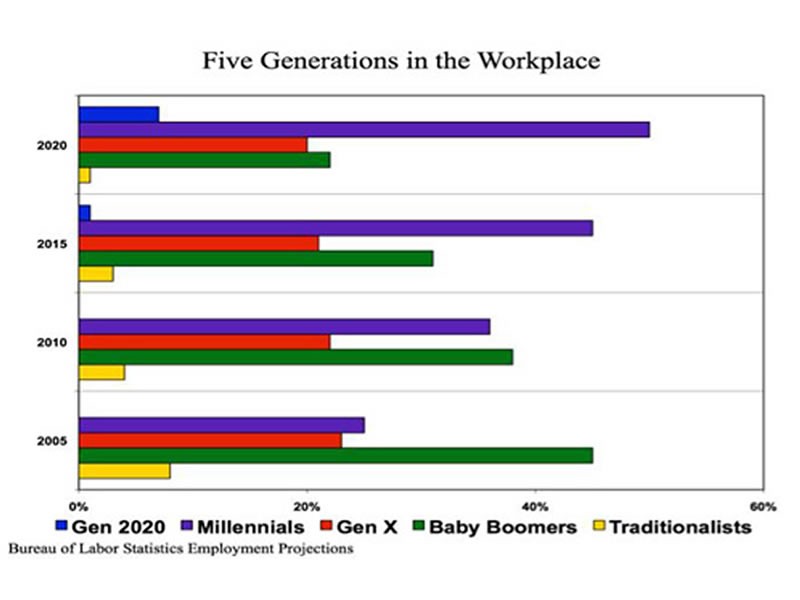Insight Blog
Agility’s perspectives on transforming the employee's experience throughout remote transformation using connected enterprise tools.
14 minutes reading time
(2896 words)
Dealing With Generational Differences In The Workplace
Dealing With Generational Differences In The Workplace, and how to Understanding Generational Differences In The Workplace.
It doesn't have to be difficult to bridge the generation gap in the workplace. Learn how to manage Baby Boomers, Millennials, and other generations of workers.
Today's business environment could be the first to bring together five generations to cooperate toward common economic and commercial goals. Managing various generations in the workplace may not be as simple as it sounds for business owners and executives. Each generation has its own set of expectations, communication techniques, and viewpoints. Employers may harness the individual capabilities of their workforce and better compete in the marketplace by implementing a management approach that addresses the distinct features of different generations in the workplace.
Understanding Generational Differences In The Workplace
What is the generational gap in the workplace?
In the workplace, the generational gap refers to the differences in behavior and viewpoint between groups of people who were born at different times. Each generation grows up in a different environment, and as a result, their employment expectations may differ. Members of the silent generation, for example, are often characterized as fiscally conservative, whereas baby boomers may have more liberal fiscal tendencies. Older generations may prefer traditional kinds of communication, whereas Gen Zers are heavily tech-dependent and comfortable using social media sites.
What issues can arise from these gaps?
Misunderstandings can cause problems in handling age disparities in the workplace. When it comes to achieving employment tasks, every generation may have its own preferences and expectations. For example, Gen Xers, Baby Boomers, and Silent Generation members may be more respectful of authority than their younger colleagues. They may also place a higher value on a company's loyalty. Also, because each generation has a different preferred communication medium, there's a chance that information will be overlooked by employees who aren't as tech-savvy.
What impact does a multigenerational workplace have on management styles?
While every generation has exceptions, understanding your employees' basic framework of experience will help you grasp their point of reference and develop management practices that are acceptable. Recognize that managing various generations in the workplace isn't a one-size-fits-all situation; businesses may need to adjust as their workforce develops and grows.
How can managers bring their employees of different generations together?
To bring employees together (physically and online) across departments, consider conducting team-building events based on engaging different generations at work. Managing across generations can be as basic as providing free coffee to staff once a month or forming teams of people with varying degrees of competence to work on projects. Fewer misunderstandings and a more productive staff may result from a more understanding and flexible workplace.
5 generations in the workplace
A multigenerational workforce has numerous advantages. Different generations have different strengths and concerns, and variations in approaches and expectations can lead to conflict. Companies can create efficient human capital management strategies by studying the work patterns of each generation and anticipating their demands. Note that the dates used to determine every generation are estimates; some of your employees' experiences may be more similar to those of a previous or subsequent generation.
Generation Z (1997–2012)
- •Millennials (1981–1996)
- •Generation Xers (1965–1980)
- •Baby boomers (1946–1964)
- •Silent generation (1928 and 1945)
Multi-Generational Group Games
1. Deep Sea Adventure (Anitra suggests easier press your luck games – Zombie Dice, Batman Dice, or Can't Stop)
2. Qwingo or a similar easy-to-approach roll-and-write game. This allows everyone to talk and interact while working on their own individual scoresheet.
3. Stop Thief! – easy to approach by non-gamers. Fun to race and catch the thieves.
4. Concept – or other party guessing games. But Concept feels very unique while still being quick to pick up. Partly because there aren't teams! (other options: CrossTalk, Taboo, Charades, Codenames, etc.)
5. Anomia or Duple – how about Anomia Kids?
6. Go Nuts for Donuts – this has been a huge hit with our kids, and the adults they've dragooned into it all seem to enjoy it too.
7. Maze Racers (two-player but speedy rounds)
8. Funky Chicken (coming soon from Happy Planet / North Star Games) or Happy Salmon – fun to watch even if you don't want to play.
Generational Icebreaker Games
According to our 2017 Employee Engagement Report, only 24% of workers feel connected to their peers. In other words, more than three out of every four employees at the average organization feel at least a bit isolated. Consider checking out free AI icebreaker generators to help you quickly create game ideas.
- Two truths and one lie. A bunch of new hires starting today?
- Find 10 things in common. This is probably one of the best icebreakers for large groups.
- Whodunit.
- The scavenger hunt.
- Human rock-paper-scissors.
- The one-word icebreaker game.
- The Marshmallow Challenge.
Five Generations In The Workplace Chart
Managing five generations in a workplace is key to better efficiency. If you're able to train the different age groups by optimizing the workflow and training them the basics of interaction with each other then you've essentially won half the battle in a multi-generational office.
Corporations had realized this way sooner. Generations training in the workplace is a time-tested and proven method of improving overall productivity. It's about time you also get started. Learn more
Breakdown on Generations
1. Generation Z
Generation Z is made up of people born between 1997 and 2012. They may regard smartphones and other technology as indispensable because they were raised as digital natives. Because of the way technology has impacted their connections, people can be more focused on the essence of a person – amusing, witty, and brilliant— rather than issues like race or ethnicity, compared to prior generations. Student debt is a major concern for Gen Z, influencing both employment options and remuneration requirements.
How to impress and keep Generation Z workers
Employers should develop a strong brand across digital channels while attracting and managing Gen Z in the workplace. When looking for employment, employees of this generation frequently use the internet and social media. When given access to cutting-edge technology, Gen Zers may be more actively engaged in their professions once hired. They are ready to begin their jobs and place a higher value on pay over benefits.
Gen Z's ideal workplace environment
Generation Z is concerned about job security after witnessing their parents deal with the aftermath of the financial crisis of 2007–2008. They seek jobs that are somewhat steady, and they plan to stay with the same employer for two to four years before moving on. They may appreciate some flexibility in how they complete duties at work, as well as the ability to contribute to process changes. They also may prefer flexible work schedules and seek out workplaces that value social responsibility and equality.
What a Gen Z employee wants in terms of management
Gen Zers want to be a part of management teams that work closely together. These young workers turn to management to develop a strong overall mission and to lead by example in order to learn and grow. Companies should focus on attracting the proper personnel, investing in their growth, and offering mentorship, coaching, and learning opportunities with senior staff when developing management policies for this generation.
Employee benefits Gen Zers want
More than health care or training and development, workplace flexibility is the most desired benefit for employees in this age range. Other priorities in terms of advantages include:
•Assistance with student debt
•Competitive salaries
•Financial incentives
•Tuition reimbursement
•Formal training opportunities
2. Millennials
Millennials, the largest generation in the workforce today, were born between 1981 and 1996. Many of them began working during a downturn, which has had a significant impact on how they envision their long-term employment. They grew up as society was transformed by the internet, and they are more at ease talking online than prior generations. Millennials own smartphones in greater numbers than previous generations, and they are quicker to adopt new social media platforms. If only for the sake of expediency, individuals of this generation may choose to send instant chats, emails, or texts rather than walk across the room to converse with someone.
How to attract and retain Millennials
Millennial job prospects are increasingly expecting a technology-driven application process, which includes mobile-optimized applicant tracking systems, LinkedIn-integrated apps, and learning about employment opportunities through social recruitment. Building a skill-structured training program that fulfills their need for leadership training, skill development, and career growth should be the emphasis of retention efforts.
Millennials' ideal workplace environment
Companies should tap into Millennials' yearning for a greater sense of purpose while designing a workplace for them to thrive in. Assist them with comprehending your company's mission and how it contributes to making people's lives, industries, or the globe a better place. If their job tasks can be done outside of the office, allow them to work remotely.
How a Millennial worker wants to be managed
Millennials value high performance and hold their supervisors accountable for the quality of their job. They, in turn, want to be judged on their accomplishments rather than their working hours. When it comes to speaking about work with Millennials, managers should be open and honest and encourage employees to ask questions.
Employee benefits Millennials want
Career development opportunities, as well as benefits that priorities a work/life balance, are important to Millennials. Here are a few examples:
•Career development programs
•Monetary gifts
•Opportunities to give back
•On-site daycare
•Mortgage services
3. Generation X
Gen Xers, trapped between the baby boomers and the Millennials and were shaped by the development of personal computers. This generation, which was born between 1965 and 1980, has a higher educational level than prior generations. Gen Xers are frequently seen as financially responsible because they are self-reliant and productive.
How to attract and maintain Generation X workers
Technology and online recruitment and hiring tools are familiar to Gen Xers, but they are equally at ease with face-to-face encounters.
Gen X's ideal workplace environment
Members of this age may desire a work atmosphere that places a greater premium on individuality. They may want more physical and psychological space, as well as more freedom in managing their workload.
How a Gen X worker prefers to be managed
When it comes to executing employment tasks, Gen Xers desire less oversight and more autonomy. They are at ease using a variety of communication methods, both online and in person. Managers should value Gen Xers' experience because they are well into their careers. This generation may also have settled into family life and prefer a more flexible schedule that allows them to strike a healthy work/life balance.
Employee benefits Gen Xers want
Healthcare coverage, flexible work arrangements, on-site daycare, and other amenities that facilitate a work/life balance may be especially important to Gen Xers raising their families. Furthermore, this generation values monetary advantages such as:
•Monetary gifts
•Stock options
•Gift cards
•Tuition reimbursement
•Mortgage services
4. Baby boomers
Baby boomers, those born between 1946 and 1964, have long been noted for their strong work ethic and goal-oriented characteristics. They are usually diligent and place a high emphasis on face-to-face engagement. They didn't grow up with computers, but they will use them for work-related purposes.
How to attract and retain baby boomers
Traditional recruiting practices, such as preparing formal resumes and conducting face-to-face interviews, may be more familiar to older employees. Advertisements, word of mouth, and recommendations may be more effective ways for them to find work. The best retention methods for this generation focus on publicly acknowledging their accomplishments through public ceremonies or other rewards that they can share with their family, friends, and coworkers.
Baby boomers' ideal workplace environment
Because baby boomers are less likely to change jobs, employment security appeals to them. They may value a more structured, formalized environment than younger generations. They're more open to interaction in group meetings because they didn't grow up with internet communication.
The management style of a baby boomer employee
Baby boomers are known for their hard work and desire to be recognized for their accomplishments. They are frequently excellent sources of information about their sector and welcome the opportunity to share their knowledge. Managers should search for ways to put their expertise to good use and encourage their employees to mentor younger workers.
Employee benefits baby boomers want
Because many members of this generation are approaching retirement, they value employment practices that allow them to be flexible. If offered modified schedules, the possibility of working from home, or other hours, many experienced employees will consider staying on the job longer. Health insurance and retirement benefits, such as a 401(k) match, are also sought after.
5. Silent generation
The silent generation, born between 1928 and 1945, is today the oldest in the workforce. They grew up without much of the contemporary comforts that younger generations take for granted. Many members of this generation have lived through difficult economic times and have developed responsible financial practices as a result. They are dedicated workers who have strong ideals.
How can you attract and retain the silent generation?
Companies can recruit and keep individuals from this generation by emphasizing basics. They want to feel like they're being adequately compensated for a job well done.
The ideal working environment for the silent generation
Although this age values modern technology, they may not be as familiar with or comfortable with it as previous generations. Providing offline options for completing tasks can help older employees feel more at ease at work. They cherish human contacts, just like the baby-boom generation, and can be effective when given the opportunity to meet face-to-face.
How a member of the silent generation would like to be managed
Discussions with these workers in-person can help explain goals and offer management with feedback. Encourage them to share their knowledge and expertise with the rest of the team.
The silent generation demands employee benefits
Employees of the silent generation may be more concerned with healthcare and retirement benefits because they have been with the company for a long time. They may be working to save for retirement through long-term employment. As people near complete retirement, they may prefer flexible employment practices, such as paid time off.
How to bridge generational differences at work
In terms of experience and innovative problem-solving skills, today's multigenerational workforce provides substantial benefits to employers. Adapting an office environment to meet the needs of different generations in the workplace can help everyone achieve their full potential. When working with a multigenerational workforce, it's critical to be aware of different work styles and communicate through a number of methods. Employees from earlier generations may be more accustomed to printed materials and having more instant access to management to address their inquiries, whereas younger employees may prefer to receive information online. Employees should be offered a variety of benefits options, and recruitment and retention strategies should be implemented across a variety of channels.
Incorporate senior staff's knowledge into training
Aim to use senior staff members' and older generations' experience to train and guide younger generations in the workplace. This can be done by establishing mentorship and coaching programs to pass on knowledge and best practices. For both seasoned and less-experienced employees, encouraging informal mentorship while on the job can be rewarding.
Recognize which employee benefits to provide to various generations
Employees at various stages of their lives may be more concerned with specific aspects of their compensation and benefits packages. Salaries, tuition assistance, and formal training opportunities may be more important to younger employees. Healthcare insurance, flexible workforce arrangements, and work/life balance may be particularly important to employees with young families. Employees who have been with the company for a long time may be more concerned about healthcare and retirement benefits. These are broad generalizations, but they do highlight the fact that different topics may be more important at different times in one's life.
There are three options for companies to respond. The first step is to recognize the need for a variety of benefits to meet employees' changing and increasing needs. The second is to recognize the need to convey potential benefits to prospective employees at various stages. Last but not least, consider whether branded messages are acceptable for some benefits. Some retirement plans, for example, have specific communications collateral directed at new graduates and college recruits that emphasizes the advantages of starting to invest for retirement as soon as possible. Other suppliers may be able to offer advice on how to handle withdrawals from retirement accounts to employees approaching retirement.
Use employee demographics to guide benefits investments
Customizing benefits offers to core demographics is one technique for managing different generations in the workplace. Employee perks can differ depending on generation, as previously stated. Would an on-site daycare center, for example, be beneficial to your employees? Is it important for your staff to have access to tuition help or mortgage services? Consider your staff and the benefits that are most likely to help them succeed. Your organization may be well on its way to a sustainable benefits plan if it focuses on communication, the benefits mix, and understanding the goals of each generation.
Managing a multigenerational workforce and attracting younger employees demands an understanding of changing needs, a willingness to try new approaches of managing people, and attracting the best talent.
Categories
Blog
(2620)
Business Management
(320)
Employee Engagement
(210)
Digital Transformation
(175)
Growth
(119)
Intranets
(119)
Remote Work
(61)
Sales
(48)
Collaboration
(37)
Culture
(29)
Project management
(29)
Customer Experience
(26)
Knowledge Management
(21)
Leadership
(20)
Comparisons
(6)
News
(1)
Ready to learn more? 👍
One platform to optimize, manage and track all of your teams. Your new digital workplace is a click away. 🚀
Free for 14 days, no credit card required.
















